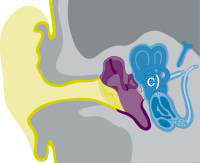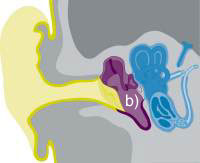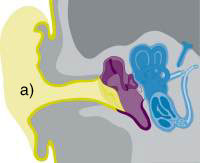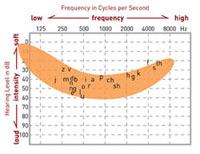A better understanding of hearing loss begins by understanding how hearing works. Your ear is an amazing organ that, very simply put, turns sound waves in the air into information in your brain — and sometimes emotions in your heart. It can perceive sounds from barely audible to very loud, differentiate their loudness and distance, and pinpoint the direction of a sound source to an amazing degree of accuracy.
The Outer Ear
The outer ear consists of the visible part of the ear, also called the auricle, and the ear canal. What we call “noises” are actually just “sound waves”, which are transmitted by the air. Sound waves are collected and guided through the ear canal to the eardrum. This tube like passageway is lined with tiny hairs and small glands that produce ear wax. The eardrum is a flexible, circular membrane that vibrates when sound waves strike it.

The Middle Ear
The middle ear is an air-filled space separated from the outer ear by the eardrum, or the tympanic membrane. In the middle ear are three tiny bones: malleus, incus, and stapes, often referred to as the hammer, the anvil, and the stirrup. They are collectively known as the ossicles. These form a bridge from the eardrum to the inner ear. When sound waves reach the eardrum, the impact creates vibrations, which are transferred through the ossicles and in doing so, amplify and relay the sound to the inner ear via the oval window. The middle ear is also connected to the throat via the eustachian tube which keeps the air pressure in the middle ear equal to that of the surrounding environment.

The Inner Ear
The inner ear referred to as the cochlea, is similar in shape to a snail shell. It contains several membranous sections filled with fluids and lined with thousands of microscopic hairs. When the ossicles conduct sound to the oval window, the fluid begins to move, thus stimulating and bending the hair cells, inside the cochlea. The bending of these hairs sends electrical impulses via the auditory nerve to the brain where it will be interpreted as sound. The inner ear also processed information affecting balance by the semicircular canals.

Basics of Sound
When we assess hearing, we are interested in both the loudness (intensity) and the pitch (frequency). The unit of measure for intensity is the decibel (dB). A decibel unit expresses the relative intensity of sounds on a scale from zero for the average least perceptible sound to about 100 dB, which is near the level most people find uncomfortably loud. Normal speech is around 50 to 60 dB. The following chart demonstrates the sound scale in decibels.
When an individual is over-exposed to excessive sound levels, sensitive structures of the inner ear, such as hair cells, can be damaged, causing noise-induced hearing loss (NIHL).
Consonant & vowels
Regarding the pitch of sound, most human ears can detect frequencies (expressed in Hertz or Hz) as low as 20 Hz and as high as 16,000 to 20,000 Hz. Not all of these frequencies are directly related to diagnostic audiology or speech understanding, and for that reason hearing tests usually are conducted for key frequencies between the range of 250 and 8000 Hz. Speech is composed of both vowels and consonants. In general, the vowels are of greater intensity and lower frequency. In contrast, the consonants are of lesser intensity and higher frequency. As a result, vowels contribute the greatest to the “loudness sensation” of speech, whereas consonants contribute most significantly to the “understanding” of speech.


